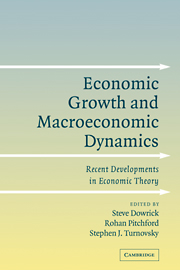Book contents
- Frontmatter
- Contents
- Preface
- Contributors
- PART ONE TOPICS IN GROWTH THEORY
- PART TWO STATISTICAL ISSUES IN GROWTH AND DYNAMICS
- PART THREE DYNAMIC ISSUES IN INTERNATIONAL ECONOMICS
- 6 Dynamic Trade Creation
- 7 Substitutability of Capital, Investment Costs, and Foreign Aid
- 8 Microchurning with Smooth Macro Growth: Two Examples
- Index
6 - Dynamic Trade Creation
Published online by Cambridge University Press: 31 October 2009
- Frontmatter
- Contents
- Preface
- Contributors
- PART ONE TOPICS IN GROWTH THEORY
- PART TWO STATISTICAL ISSUES IN GROWTH AND DYNAMICS
- PART THREE DYNAMIC ISSUES IN INTERNATIONAL ECONOMICS
- 6 Dynamic Trade Creation
- 7 Substitutability of Capital, Investment Costs, and Foreign Aid
- 8 Microchurning with Smooth Macro Growth: Two Examples
- Index
Summary
INTRODUCTION
The emergence of large trading blocs as a central feature of the world economy has led to renewed interest in customs unions and free trade areas. Analysis of preferential trading arrangements has traditionally focused on static trade creation and diversion. However, as world capital markets have become increasingly integrated, it is clear that the dynamic effects of trade policy are also of great significance.
The analysis of preferential trading areas necessarily involves changes from a tariff-ridden equilibrium, so we are already in a world of the second best. Hence, it would not help further to muddy the analytical waters by assuming that the source of growth is some economy-wide externality. Thus we are drawn to the class of growth models studied by Jones and Manuelli (1990) and Rebelo (1991). Also, because we are interested in the effects of commercial policies across time, it is natural to assume that agents do not live forever. Thus, we maintain analytical simplicity by imposing the discipline of a strictly neoclassical framework with no increasing returns and no bequest motives.
The burden of this discipline is that endogenous economic growth can occur only if the economy has at least two sectors. The most natural economy has a consumption sector, an investment sector, a reproducible factor, and a fixed factor. Boldrin (1992) and Jones and Manuelli (1992) show implicitly that one-sector growth models ignore a crucial element in the development process: that investment goods become cheaper over time so that the fixed factor can afford an increasingly large stock of the reproducible factor from a finite stream of revenues.
- Type
- Chapter
- Information
- Economic Growth and Macroeconomic DynamicsRecent Developments in Economic Theory, pp. 115 - 137Publisher: Cambridge University PressPrint publication year: 2004



